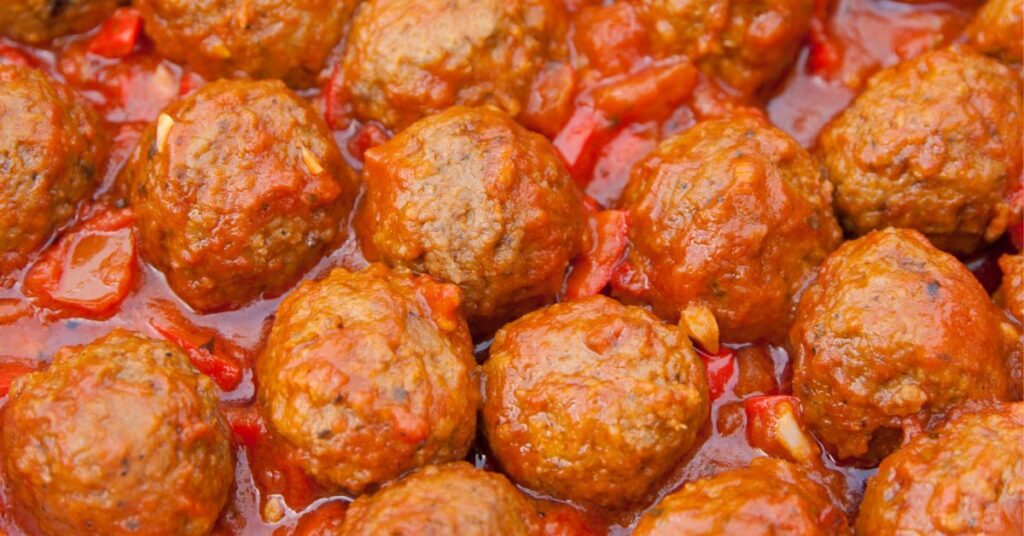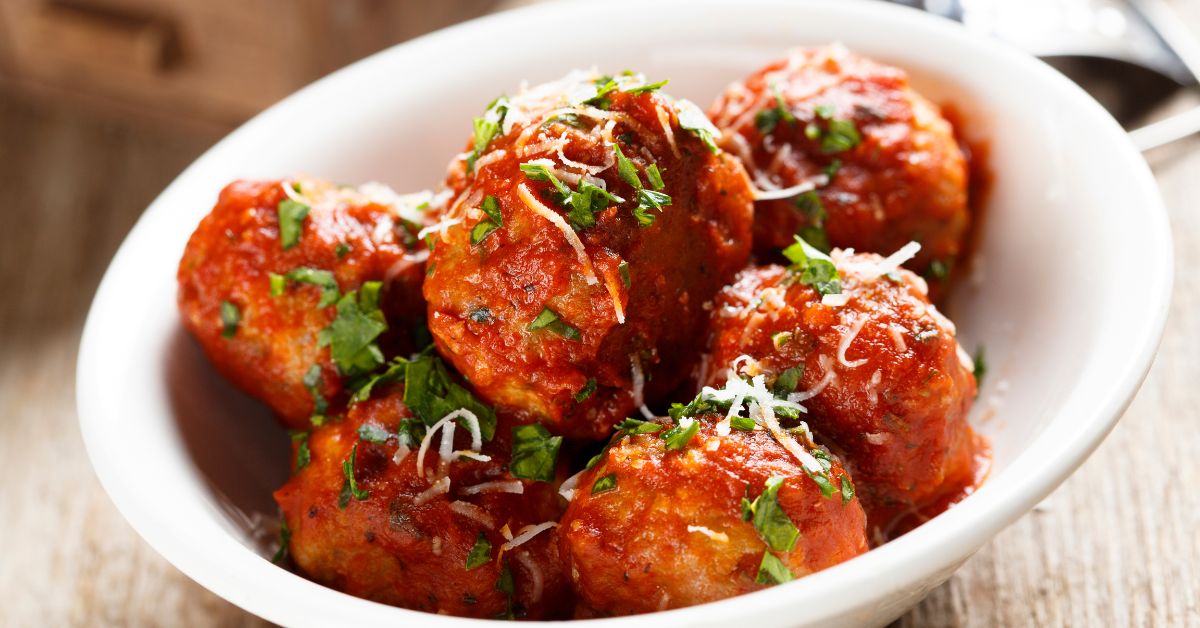Dr. Pepper Meatballs, a culinary delight that marries the iconic taste of a beloved soda with the savory goodness of meatballs, have emerged as a standout dish in the world of comfort food. This unique recipe has gained immense popularity, captivating the taste buds of food enthusiasts and home cooks alike. The fusion of Dr. Pepper’s distinct, 23-flavor blend with the rich, meaty texture of the meatballs creates a flavor profile that is both intriguing and irresistible. This dish is not just a testament to culinary creativity but also a celebration of bold flavors, making it a favorite at gatherings, potlucks, and family dinners. The allure of Dr. Pepper Meatballs lies in their ability to offer a sweet and tangy twist to the traditional meatball, turning an ordinary meal into an extraordinary experience.
Why Dr. Pepper in Meatballs?
The Unique Flavor Profile of Dr. Pepper
Dr. Pepper, known for its secret blend of 23 flavors, offers a complex and unique taste that is both sweet and spicy. This distinctive flavor profile makes it an intriguing ingredient in culinary applications. When used in meatballs, Dr. Pepper infuses them with a depth of flavor that is hard to replicate with other ingredients. The soda’s notes of cherry, licorice, almond, and vanilla add a subtle sweetness and richness, enhancing the overall taste of the meatballs.
How Dr. Pepper Complements Meat Dishes
The reason Dr. Pepper works so well in meat dishes, particularly meatballs, lies in its ability to balance savory flavors with its own sweet and tangy character. The caramelization that occurs when meatballs are cooked with Dr. Pepper not only adds a beautiful glaze but also intensifies the meat’s natural flavors. This combination creates a harmonious blend of sweetness and savoriness, making Dr. Pepper meatballs a delightful contrast to more traditional meat dishes.
Benefits of Cooking with Soda
Cooking with soda like Dr. Pepper brings several benefits:
- Flavor Enhancement: Sodas contain acids, such as phosphoric or citric acid, which help in tenderizing meat and enhancing its flavor.
- Tenderizing Effect: The carbonation in sodas can tenderize the meat, making the meatballs juicier and more succulent.
- Glazing Property: The sugar content in soda caramelizes during cooking, providing a delicious glaze that adds to the visual appeal and taste.
- Versatility: Soda can be used with various types of meat, offering a simple way to add a unique twist to numerous recipes.
Incorporating Dr. Pepper into meatballs is not just about adding a quirky soda into the mix; it’s about leveraging its unique flavor profile to elevate a classic dish to new culinary heights.
Key Ingredients
Overview of Essential Ingredients for Dr. Pepper Meatballs
To create the perfect Dr. Pepper Meatballs, a balance of the following key ingredients is essential:
- Ground Meat: Traditionally, ground beef is used for its rich flavor and ideal fat content, which ensures juicy meatballs.
- Breadcrumbs: They help in binding the meatballs and add a subtle texture.
- Egg: Acts as a binder, holding the meatballs together during cooking.
- Seasonings: A combination of garlic powder, onion powder, salt, and pepper is typically used to enhance the meat’s natural flavors.
- Dr. Pepper: The star ingredient, it adds a unique sweetness and depth to the sauce.
- Barbecue Sauce: Complements the Dr. Pepper with its tangy and slightly smoky flavor.
- Brown Sugar: Enhances the sauce’s sweetness and helps in caramelization.
- Worcestershire Sauce: Adds a touch of umami and complexity to the sauce.
Substitutes and Variations
- For the Meat:
- Turkey: A leaner alternative to beef, turkey can be used for a healthier version.
- Vegan Meatballs: Plant-based meat substitutes can be used for a vegan variation. Ensure they hold up well during cooking.
- For Breadcrumbs:
- Gluten-Free Breadcrumbs: For a gluten-free version, use gluten-free breadcrumbs.
- Oats: Ground oats can be a healthier alternative.
- For Egg (binding):
- Flaxseed Meal: Mix flaxseed meal with water for a vegan binder.
- Mashed Potatoes: Can also be used for binding in vegan recipes.
- For Dr. Pepper:
- Other Sodas: Root beer or cola can be used for a different yet similar flavor profile.
- For BBQ Sauce:
- Homemade Sauce: For a more personalized flavor, a homemade barbecue sauce can be used.
- For Brown Sugar:
- Honey or Maple Syrup: These natural sweeteners can be used for a different kind of sweetness.
These ingredients and their substitutes offer flexibility, allowing you to tailor the recipe to meet dietary preferences and experiment with flavors. Whether you stick to the classic recipe or opt for a variation, the essence of Dr. Pepper Meatballs lies in the perfect harmony of sweet, tangy, and savory notes.
Step-by-Step Recipe
Detailed Instructions for Making Dr. Pepper Meatballs
- Preparation of Meatballs:
- In a large bowl, combine 1 pound of ground meat (beef or turkey), 1/2 cup of breadcrumbs, 1 beaten egg, 1 teaspoon each of garlic powder and onion powder, and salt and pepper to taste.
- Mix the ingredients gently but thoroughly. Over-mixing can make the meatballs tough.
- Form the mixture into small, evenly sized balls, about 1 inch in diameter.
- Cooking the Meatballs:
- In a skillet over medium heat, brown the meatballs on all sides. This should take about 10 minutes. They don’t need to be cooked through at this stage.
- Once browned, remove the meatballs from the skillet and set aside.
- Preparing the Dr. Pepper Sauce:
- In the same skillet, combine 1 cup of Dr. Pepper, 1 cup of barbecue sauce, 2 tablespoons of brown sugar, and 1 tablespoon of Worcestershire sauce.
- Bring the mixture to a simmer, stirring occasionally.
- Combining Meatballs and Sauce:
- Add the meatballs back into the skillet with the sauce.
- Cover and simmer for about 20-30 minutes, or until the meatballs are cooked through and the sauce has thickened.
Tips for Perfect Meatballs
- Use Lean Meat: A lean-to-fat ratio of 80/20 is ideal for juicy yet not overly greasy meatballs.
- Don’t Overwork the Meat: Mix just until the ingredients are combined to keep the meatballs tender.
- Consistent Size: Ensure all meatballs are the same size for even cooking.
- Browning: Brown the meatballs before simmering in the sauce for added flavor and texture.
Variations in Cooking Methods
- Crockpot Method:
- Place the browned meatballs in a crockpot.
- Pour the Dr. Pepper sauce over the meatballs.
- Cook on low for 3-4 hours or on high for 1-2 hours.
- Instant Pot Method:
- Use the sauté function to brown the meatballs in the Instant Pot.
- Add the sauce to the pot and close the lid.
- Cook on manual high pressure for 7 minutes, then quick release the pressure.
- Oven Method:
- Preheat the oven to 375°F (190°C).
- Place browned meatballs in a baking dish and cover with sauce.
- Bake for 20-25 minutes or until cooked through.
Each method has its own benefits: the crockpot is ideal for slow cooking and flavor infusion, the Instant Pot for a quick and easy meal, and the oven for a more traditional approach. Choose the method that best suits your time and taste preferences.
Nutritional Information
Breakdown of Nutritional Content
A typical serving of Dr. Pepper Meatballs contains the following nutrients (approximations based on standard ingredients):
- Calories: Varies, but approximately 250-300 calories per serving (4-5 meatballs).
- Protein: Ground beef or turkey provides a good source of protein, with about 15-20 grams per serving.
- Carbohydrates: Primarily from the Dr. Pepper and breadcrumbs, ranging from 20-30 grams per serving.
- Fats: Depending on the meat used, fat content can range from 10-15 grams per serving.
- Sugars: The Dr. Pepper and barbecue sauce contribute to the sugar content, which can be around 10-15 grams per serving.
- Sodium: Store-bought barbecue sauce and Worcestershire sauce can add significant sodium, approximately 500-700 mg per serving.
Discussing Health Considerations
- Moderation is Key: Due to the sugar and sodium content, these meatballs should be enjoyed in moderation, especially for those monitoring their sugar or sodium intake.
- Lean Meat Options: Opting for leaner meats like turkey can reduce the fat content.
- Homemade Substitutes: Making your own barbecue sauce can help control the amount of sugar and sodium.
- Balanced Diet: Pair these meatballs with healthier sides to create a more balanced meal.
Pairing Suggestions
What to Serve with Dr. Pepper Meatballs
- Starches: Serve with mashed potatoes, rice, or a crusty loaf of bread to soak up the delicious sauce.
- Vegetables: Steamed vegetables, a crisp salad, or roasted veggies offer a fresh contrast to the rich meatballs.
- Pasta: A simple spaghetti or penne pasta can complement the meatballs for a heartier meal.
The key to pairing is balancing the rich, sweet, and tangy flavors of the meatballs with the drink or side dishes. Whether opting for a classic or a more casual, the goal is to enhance the overall dining experience.
Storing and Reheating Tips
Best Practices for Storing Leftovers
- Cooling: Allow the meatballs to cool to room temperature before storing.
- Refrigeration: Place the meatballs in an airtight container and refrigerate. They typically last up to 3-4 days.
- Freezing: For longer storage, freeze the meatballs in a freezer-safe container or bag. They can be stored for up to 3 months. Label the container with the date for reference.
How to Reheat for Best Taste
- Microwave: For a quick option, reheat the meatballs in the microwave. Cover them and heat on medium power to avoid drying them out.
- Stovetop: Reheat in a saucepan over medium heat, stirring occasionally, until heated through. This method helps retain the moisture.
- Oven: Place the meatballs in an oven-safe dish, cover with foil, and reheat at 350°F (175°C) for about 10-15 minutes.
Customizing the Recipe
Adjusting the Recipe for Dietary Needs
- Gluten-Free: Use gluten-free breadcrumbs or a substitute like rolled oats. Ensure that all other ingredients, like barbecue sauce and Worcestershire sauce, are gluten-free.
- Low-Carb: Replace breadcrumbs with almond flour or ground flaxseed for a low-carb alternative. Use a low-sugar or sugar-free version of Dr. Pepper and barbecue sauce.
Creative Twists and Variations
- Spicy Version: Add chili flakes or hot sauce to the meatball mixture or sauce for a spicy kick.
- Cheese-Stuffed Meatballs: Insert a small cube of cheese (like mozzarella or cheddar) in the center of each meatball before cooking.
- Different Meats: Experiment with a mix of ground meats, such as pork and beef, or even ground chicken for a different flavor profile.
- Vegetarian Option: Use plant-based meat substitutes to make vegetarian meatballs. Adjust the cooking time as needed, as they may cook faster than traditional meatballs.
- Herb Infusion: Add fresh herbs like parsley, basil, or oregano to the meatball mixture for added freshness and flavor.
- BBQ Twist: For a barbecue flair, mix in some smoked paprika or liquid smoke into the sauce.
These customizations allow you to tailor the recipe to suit various tastes and dietary requirements, making Dr. Pepper Meatballs a versatile dish that can be enjoyed by many. Whether sticking to the classic recipe or experimenting with these variations, the key is to maintain the balance of flavors that make this dish so uniquely appealing.
FAQs
Are Dr. Pepper Meatballs Gluten-Free?
- No, traditional Dr. Pepper Meatballs are not gluten-free due to the breadcrumbs and potentially the barbecue sauce. However, you can make them gluten-free by using gluten-free breadcrumbs and ensuring all other ingredients, like the barbecue sauce, are gluten-free.
Can I Make Dr. Pepper Meatballs in a Slow Cooker?
- Absolutely! Slow cooking Dr. Pepper Meatballs is an excellent method. Simply place browned meatballs in the slow cooker, pour the Dr. Pepper sauce over them, and cook on low for 3-4 hours or high for 1-2 hours. This method enhances the flavors and tenderizes the meatballs.
What Are the Best Meatballs to Use for This Recipe?
- The best meatballs for this recipe are homemade meatballs made from ground beef or turkey. For convenience, you can also use high-quality store-bought frozen meatballs. The key is to choose meatballs that are flavorful and hold their shape well during cooking.
Can I Use a Different Soda for This Recipe?
- Yes, you can use other sodas to create a similar effect. Root beer or cola are good alternatives that offer a similar sweet and tangy profile. Each soda will impart its unique flavor, giving a different twist to the dish.
How Long Can I Store Dr. Pepper Meatballs?
- Dr. Pepper Meatballs can be stored in the refrigerator for 3-4 days in an airtight container. For longer storage, they can be frozen for up to 3 months. Ensure they are stored properly to maintain their flavor and texture.

Dr. Pepper Meatballs
- Total Time: 45 minutes
Ingredients
- 1 lb ground beef 🥩
- 1/2 cup breadcrumbs 🍞
- 1 egg 🥚
- 1/4 cup onion, finely chopped 🧅
- 1 clove garlic, minced 🧄
- 1/2 teaspoon salt 🧂
- 1/4 teaspoon black pepper 🌑
- 1 cup Dr. Pepper soda (non-alcoholic) 🥤
- 1/2 cup ketchup 🍅
- 1/4 cup Worcestershire sauce 🥣
- 1 tablespoon soy sauce 🍶
- 1 tablespoon apple cider vinegar 🍏
- 2 tablespoons brown sugar 🟤
- 1 tablespoon cornstarch 🌽
- 2 tablespoons water 💧
Instructions
- In a large bowl, combine ground beef 🥩, breadcrumbs 🍞, egg 🥚, onion 🧅, garlic 🧄, salt 🧂, and pepper 🌑. Mix well.
- Form the mixture into small meatballs, about 1 inch in diameter.
- In a skillet over medium heat, brown the meatballs on all sides, then remove and set aside.
- In the same skillet, combine Dr. Pepper 🥤, ketchup 🍅, Worcestershire sauce 🥣, soy sauce 🍶, apple cider vinegar 🍏, and brown sugar 🟤. Bring to a simmer.
- Return the meatballs to the skillet and cook in the sauce for 10-15 minutes, or until cooked through.
- In a small bowl, mix cornstarch 🌽 and water 💧. Stir into the sauce to thicken.
- Serve hot, garnished with parsley if desired.
- Prep Time: 20 minutes
- Cook Time: 25 minutes
Nutrition
- Serving Size: 4
- Calories: 320 kcal
Conclusion
Dr. Pepper Meatballs are a true culinary delight, combining the unique and beloved flavors of Dr. Pepper with the comforting, familiar taste of meatballs. This dish stands out for its perfect balance of sweetness, tanginess, and savory goodness, making it a versatile choice for various occasions, from family dinners to party appetizers. The recipe’s adaptability to different cooking methods and dietary needs further adds to its appeal. Whether you’re a long-time fan of Dr. Pepper or just looking for a new twist on classic meatballs, this recipe promises a delightful and flavorful experience. So, why not give it a try and add a splash of creativity to your cooking with Dr. Pepper Meatballs?

